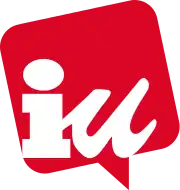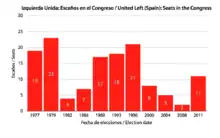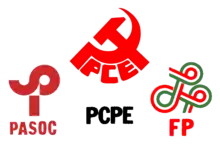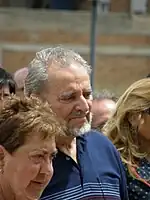United Left (Spain)
United Left (Spanish: Izquierda Unida [iθˈkjeɾðawˈniða], IU) is a federative political movement in Spain that was first organized as a coalition in 1986, bringing together several left-wing political organizations, most notably the Communist Party of Spain.[7]
United Left Izquierda Unida | |
|---|---|
 | |
| General Coordinator | Alberto Garzón |
| Founded | April 1986 (as coalition) 2 November 1992 (as party federation) |
| Youth wing | Área de Juventud de Izquierda Unida |
| LGBT wing | ALEAS |
| Membership (2019) | |
| Ideology | Communism[2] Socialism[2] Republicanism[3] |
| Political position | Left-wing to far-left[4][5] |
| National affiliation | Unidas Podemos (dissolved) Sumar |
| European affiliation | Party of the European Left |
| European Parliament group | The Left in the European Parliament – GUE/NGL |
| Colours | Red |
| Congress of Deputies | 5 / 350 |
| Spanish Senate | 0 / 266 |
| European Parliament | 2 / 59 |
| Regional Parliaments | 10 / 1,268 |
| Local Government (2015) | 2,022 / 67,515 (Candidates gained in coalitions or unitary lists[6] not included) |
| Website | |
| izquierdaunida.org | |
IU was founded as an electoral coalition of seven parties, but the Communist Party of Spain (PCE) is the only remaining integrated member of the IU at the national level.[7] Despite that, IU brings together other regional parties, political organizations, and independents.[7] It currently takes the form of a permanent federation of parties.

IU took part of the Unidas Podemos coalition and the corresponding parliamentary group in the Congreso de los Diputados between 2016 and 2023. Since January 2020, it participated for the first time in a national coalition government, with one minister. For the 2023 general election, IU took part of the Sumar platform.[8]
History


Following the electoral failure of the PCE in the 1982 (from 10% to 4%), PCE leaders believed that the PCE alone could no longer effectively challenge the electoral hegemony of the Spanish Socialist Workers' Party (PSOE) on the left.[7] With this premise, the PCE began developing closer relations with other left-wing groups, with the vision of forming a broad left coalition.[7] IU slowly improved its results, reaching 9% in 1989 (1,800,000 votes) and nearly 11% in 1996 (2,600,000 votes). The founding organizations were: Communist Party of Spain, Progressive Federation, Communist Party of the Peoples of Spain, PASOC, Carlist Party, Humanist Party, Unitarian Candidacy of Workers, and Republican Left.
In contrast to the PCE prior to the formation of IU, which pursued a more moderate political course, the new IU adopted a more radical strategy and ideology of confrontation against the PSOE.[9][7] IU generally opposed cooperating with the PSOE, and identified it as a "right-wing party", no different from the People's Party (PP).[9][7]
After achieving poor results in the 1999 local and European elections, IU decided to adopt a more conciliatory attitude towards the PSOE, and agreed to sign an electoral pact with the PSOE for the upcoming general election in 2000.[7] They also adopted a universal policy in favor of cooperating with the PSOE at local level.[7]
Following the election of Cayo Lara as leader in 2008, however, the party has shifted back towards a more confrontational attitude towards the PSOE.
IU currently has around 70,000 members.[10]
Composition
| Party | Notes | |
|---|---|---|
| Communist Party of Spain (PCE) | ||
| Progressive Federation (FP) | Left in December 1987. | |
| Communist Party of the Peoples of Spain (PCPE) | Left in 1988. | |
| Socialist Action Party (PASOC) | ||
| Carlist Party (PC) | ||
| Humanist Party (PH) | ||
| Unitarian Candidacy of Workers (CUT) | ||
| Open Left (IzAb) | Formed in February 2012, left in December 2018. | |
| Republican Left (IR) | ||
| The Dawn. Marxist Organization OM (La Aurora (om)) | ||
| Feminist Party of Spain (PFE) | Joined in October 2015, expelled in February 2020. | |
| Ecosocialists of the Region of Murcia (ESRM) | ||
| Initiative for El Hierro (IpH) | ||
Federations of IU
- Andalusia: Izquierda Unida Los Verdes - Convocatoría por Andalucía (United Left/The Greens - Assembly for Andalusia)
- Aragon: Izquierda Unida Aragón (United Left of Aragon)
- Asturias: Izquierda Xunida de Asturies (United Left of Asturias)
- Balearic Islands: Esquerra Unida de les Illes Balears (United Left of the Balearic Islands)
- Canary Islands: Izquierda Unida Canaria (Canarian United Left)
- Cantabria: Izquierda Unida de Cantabria (Cantabrian United Left)
- Castilla-La Mancha: Izquierda Unida de Castilla-La Mancha (United Left of Castilla-La Mancha)
- Catalonia: Esquerra Unida Catalunya (United Left Catalonia, Founded in July 2019; suspended in June 2019 Esquerra Unida i Alternativa)[11]
- Castilla y León: Izquierda Unida de Castilla y León (United Left of Castile and León)
- Ceuta: Izquierda Unida de Ceuta (United Left of Ceuta)
- Euskadi: Izquierda Unida - Los Verdes: Ezker Anitza (United Left - The Greens: Plural Left)
- Extremadura: Izquierda Unida Extremadura (United Left Extremadura)
- Galicia: Esquerda Unida (United Left of Galicia)
- La Rioja: Izquierda Unida La Rioja (United Left-La Rioja)
- Madrid: Izquierda Unida-Madrid (United Left-Madrid).[12] Izquierda Unida de la Comunidad de Madrid (United Left of the Community of Madrid) was expelled in 2015. The new federation, IU-M, was created in 2016.[13]
- Melilla: Izquierda Unida - Federación de Melilla (United Left - Melilla Federation)
- Murcia: Izquierda Unida-Verdes de la Región de Murcia (United Left - Greens of the Region of Murcia)
- Navarra: Izquierda Unida de Navarra - Nafarroako Ezker Batua (United Left of Navarra)
- Valencian Community: Esquerra Unida del País Valencià (United Left of the Valencian Country)
Leaders
| Name | Period | Notes |
|---|---|---|
| Gerardo Iglesias | 1986 | |
| Julio Anguita | 1986–1999 | |
| Francisco Frutos | 1999-2001 | |
| Gaspar Llamazares | 2001–2008 | |
| Cayo Lara | 2008–2016 | |
| Alberto Garzón | 2016–present |
Electoral performance
Cortes Generales
| Cortes Generales | |||||||||
| Election | Leading candidate | Congress | Senate | Gov. | |||||
|---|---|---|---|---|---|---|---|---|---|
| Votes | % | # | Seats | +/– | Seats | +/– | |||
| 1986 | Gerardo Iglesias | 935,504 | 4.6 | 5th | 7 / 350 |
0 / 208 |
Opposition | ||
| 1989 | Julio Anguita | 1,858,588 | 9.1 | 3rd | 17 / 350 |
1 / 208 |
Opposition | ||
| 1993 | 2,253,722 | 9.6 | 3rd | 18 / 350 |
0 / 208 |
Opposition | |||
| 1996 | 2,639,774 | 10.5 | 3rd | 21 / 350 |
0 / 208 |
Opposition | |||
| 2000 | Francisco Frutos | 1,263,043 | 5.4 | 3rd | 8 / 350 |
0 / 208 |
Opposition | ||
| 2004 | Gaspar Llamazares | 1,284,081 | 5.0 | 3rd | 5 / 350 |
1 / 208 |
Support | ||
| 2008 | 969,946 | 3.8 | 3rd | 2 / 350 |
1 / 208 |
Opposition | |||
| 2011 | Cayo Lara | with Plural Left | 7 / 350 |
0 / 208 |
Opposition | ||||
| 2015 | Alberto Garzón | with Popular Unity | 2 / 350 |
0 / 208 |
New election | ||||
| 2016 | with Unidos Podemos | 8 / 350 |
2 / 208 |
Opposition (2016–18) | |||||
| Support (2018–19) | |||||||||
| Apr-2019 | with Unidas Podemos | 5 / 350 |
0 / 208 |
New election | |||||
| Nov-2019 | with Unidas Podemos | 5 / 350 |
0 / 208 |
Coalition (PSOE–UP) | |||||
| 2023 | with Sumar | 5 / 350 |
0 / 208 |
TBD | |||||
European Parliament
| European Parliament | ||||||
| Election | Leading candidate | Votes | % | # | Seats | +/– |
|---|---|---|---|---|---|---|
| 1987 | Fernando Pérez Royo | 1,011,830 | 5.3 | 4th | 3 / 60 |
— |
| 1989 | 961,742 | 6.1 | 4th | 4 / 60 |
||
| 1994 | Alonso Puerta | 2,497,671 | 13.4 | 3rd | 9 / 64 |
|
| 1999 | 1,221,566 | 5.8 | 3rd | 4 / 64 |
||
| 2004 | Willy Meyer | 643,136 | 4.1 | 4th | 2 / 54 |
|
| 2009 | with The Left | 2 / 54 |
||||
| 2014 | with Plural Left | 4 / 54 |
||||
| 2019 | Sira Rego | with UPCE | 2 / 54 |
|||
References
- Los partidos se atribuyen ocho veces más militantes de los que admiten pagar cuotas. Público, 28/07/2019.
- Nordsieck, Wolfram (2019). "Spain". Parties and Elections in Europe. Archived from the original on 23 October 2018. Retrieved 18 February 2019.
- "European Social Survey 2012 - Appendix 3 (in English)" (PDF). European Science Foundation. 1 January 2014. Retrieved 6 May 2014.
- "Européennes : poussée du parti d'extrême gauche Izquierda Unida en Espagne". 25 May 2014.
- "Espagne : Podemos s'allie avec l'extrême gauche pour les législatives". 10 May 2016.
- Like Ahora Madrid, Barcelona en Comú or Marea Atlántica. This lists gained 3,223 town councillors.
- "Electoral incentives and organizational limits. The evolution of the Communist Party of Spain (PCE) and the United Left (IU) (in English)" (PDF). Institute of Political and Social Sciences. 2002. Retrieved 11 May 2014.
- RTVE.es (2023-06-09). "IU alcanza un acuerdo con Sumar para concurrir juntos a las elecciones". RTVE.es (in Spanish). Retrieved 2023-08-09.
- Topaloff, L (2012) Political Parties and Euroscepticism, pp192-193
- Entre coalición y partido, la evolución de modelo organizativo en IU, Luis Ramiro Archived March 26, 2012, at the Wayback Machine
- Following the tradition of the Spanish left since the formation of the Unified Socialist Party of Catalonia (PSUC) in 1936 (when communists and socialists joined forces in Catalunya), IU doesn't have any organization of its own in Catalonia. Until 1998, the referent of IU in Catalonia was Initiative for Catalonia (Iniciativa per Catalunya, now known as IC-V). But IC eventually broke relations with IU. A split in PSUC followed, and a new Catalan alliance, United and Alternative Left (Esquerra Unida i Alternativa, EUiA), was formed as the new Catalan referent of IU.
- IU rompe "a todos los efectos" con su federación madrileña. El Diario, 14/06/2015 - 10:48h. Aitor Rivero.
- La militancia de IU Madrid elige a Mauricio Valiente y Chus Alonso al frente de la nueva formación. Público, 03/05/2016.
External links
- Official website
- Izquierda Unida Los Verdes - Convocatoría por Andalucía
- Izquierda Unida Aragón
- Izquierda Xunida d'Asturies
- Izquierda Unida de Cantabria
- Izquierda Unida - Izquierda de Castilla-La Mancha
- Esquerda Unida-Izquierda Unida
- Esquerra Unida de les Illes Balears
- Izquierda Unida - La Rioja
- Izquierda Unida de la Comunidad de Madrid
- Izquierda Unida de Navarra - Nafarroako Ezker Batua
- Esquerra Unida del País Valencià